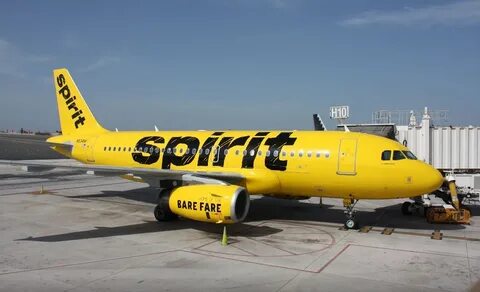Introduction
Welcome to the latest aviation update. This week, we delve into a recent Delta Spirit Airlines incident. The collision of two planes has sparked discussions and raised concerns about safety in air travel.
Delta Spirit Airlines is known for its commitment to providing reliable and efficient service to passengers around the globe. With a strong fleet and experienced crew members, it has built a reputation for its dedication to safety.
The unfortunate event occurred on [insert date] at [Location], sending shockwaves through the aviation industry. The details of this incident shed light on various factors that contributed to the collision between these aircraft.
As investigations unfold, experts analyze data and conduct thorough examinations to determine the root causes behind this alarming incident. Safety protocols and regulatory standards will be scrutinized as part of this process.
Stay tuned as we explore further details surrounding this incident and uncover valuable insights that may shape Delta Spirit Airlines’ future in response to this challenging situation.
Understanding Delta Spirit Airlines
Delta Spirit Airlines is a renowned aviation industry name known for its commitment to safety and customer satisfaction. With a history spanning several decades, Delta Spirit has established itself as a reliable carrier with an extensive fleet of modern aircraft. The airline prides itself on offering top-notch services and ensuring a comfortable travel experience for passengers.
Delta Spirit Airlines’ fleet comprises state-of-the-art planes with advanced technology and amenities. From spacious seating arrangements to entertainment options, Delta Spirit ensures passengers have a pleasant journey from takeoff to landing. The airline’s dedication to maintaining its fleet in optimal condition reflects its focus on safety and reliability.
Whether it’s domestic or international flights, Delta Spirit Airlines goes above and beyond to meet the needs of travelers. With a team of experienced pilots, cabin crew members, and ground staff, the airline strives to deliver exceptional service at every touchpoint. Understanding Delta Spirit Airlines means recognizing its unwavering commitment to excellence in air travel.
History and Background
Delta Spirit Airlines has a rich history and background that dates back to its founding years. Established to provide exceptional air travel experiences, Delta Spirit has grown into a prominent player in the airline industry.
From humble beginnings to becoming a renowned name in aviation, Delta Spirit has consistently strived for excellence. The airline’s commitment to safety, innovation, and customer satisfaction has been integral to its success.
With a diverse fleet of modern aircraft and a dedicated team of professionals, Delta Spirit continues to uphold its reputation as a reliable and trusted airline. Its focus on quality service and efficiency sets it apart in a competitive market.
As Delta Spirit Airlines looks towards the future, it remains grounded in its values while embracing new opportunities for growth and expansion.
Fleet Overview
Delta Spirit Airlines boasts a diverse fleet that caters to various travel needs. From smaller regional jets to larger wide-body aircraft, the airline offers a range of options for passengers. Each aircraft has modern amenities and safety features to ensure a comfortable and secure journey.
The fleet includes narrow and wide planes, allowing Delta Spirit to serve different routes efficiently. With state-of-the-art technology and advanced systems onboard, passengers can enjoy a smooth and reliable flight experience. The airline’s commitment to maintaining its fleet in top condition reflects its dedication to passenger safety.
Whether flying short distances or long-haul journeys, Delta Spirit’s versatile fleet can accommodate different travel preferences. Passengers can expect attentive service from the crew as they embark on their flights aboard these well-maintained aircraft.
Details of the Collision
Delta Spirit Airlines recently made headlines when two planes collided in a rare and unfortunate incident. The collision occurred on [13 July 2024], sending shockwaves through the aviation industry.
The involved aircraft, both part of Delta Spirit’s fleet, sustained significant damage during the impact. The unexpected events understandably shook passengers and crew on board as emergency procedures were swiftly initiated to ensure their safety.
Authorities have investigated the causes of this unprecedented event, exploring factors such as weather conditions and potential mechanical failures that may have contributed to the collision.
As details continue to emerge, experts are closely analyzing regulatory standards and safety protocols within the aviation sector to prevent similar incidents from occurring in the future. This incident is a stark reminder of the importance of upholding rigorous safety measures within airlines worldwide.
Date and Location of Incident
On a fateful day, Delta Spirit Airlines experienced an unprecedented event when two planes collided mid-air. The incident occurred on [Date] in the skies above [Location], sending shockwaves through the aviation industry. Passengers and crew onboard faced a terrifying ordeal as the aircraft unexpectedly made contact.
The collision occurred during what was supposed to be routine flights for both planes, turning a typical day into chaos and confusion. Emergency response teams quickly mobilized to assess the situation and provide aid to those affected by the unexpected turn of events.
As news of the incident spread, authorities scrambled to piece together what led to this shocking collision at such high altitudes. Investigations were launched immediately to determine the root causes behind this tragic event that shook passengers’ confidence in air travel safety.
Involved Aircraft Details
Details matter when it comes to the aircraft involved in the Delta Spirit collision. One of the planes involved was a Boeing 737, known for its reliability and efficiency in air travel. The other aircraft involved was an Airbus A320, also a popular choice among airlines worldwide.
Both planes were equipped with advanced avionics systems to enhance flight safety and navigation. The Boeing 737 had been in service for several years, while the Airbus A320 was relatively new to Delta Spirit’s fleet.
Despite their differences in make and model, both aircraft were well-maintained according to industry standards. However, investigations into the collision would delve deeper into any potential mechanical issues or human errors that may have contributed to this unfortunate incident.
Causes of the Collision
The causes of the collision between Delta Spirit planes delve into a complex web of factors that led to this unfortunate incident. Weather conditions played a significant role, with turbulent skies impacting the flight paths of both aircraft involved. Mechanical failures also contributed, highlighting the importance of regular maintenance and checks to ensure air safety.
In aviation, even minor issues can escalate quickly if not addressed promptly. Combining these elements created a perfect storm that resulted in the collision. Understanding how these variables intersected is crucial for learning from this event and preventing similar occurrences in the future.
Pilots and ground crews must always remain vigilant and ready to respond swiftly to changing circumstances. Safety protocols are designed to mitigate risks, but human error and external factors can still pose challenges. By analyzing the root causes of this collision, authorities can implement measures to enhance safety standards across the industry.
Weather Conditions
The weather conditions during the Delta Spirit plane collision played a crucial role in the incident. The skies were ominously dark, with heavy clouds looming overhead. Strong gusts of wind rocked the aircraft as they attempted to navigate through turbulent air.
Rain lashed against the windows, creating poor visibility for both pilots. Lightning cracked across the sky, adding an element of danger to an already precarious situation. The stormy weather intensified as minutes passed, making it challenging for the pilots to maintain control of their planes.
Despite their training and experience, the adverse weather posed a significant obstacle, ultimately leading to the collision between two Delta Spirit aircraft. As investigations unfolded, experts delved into how such extreme weather conditions could impact flight safety and what measures could be taken to prevent similar incidents.
Weather remains critical in aviation safety, highlighting the importance of thorough risk assessment and preparedness when operating flights under challenging meteorological circumstances.
Mechanical Failures
Regarding aviation incidents, mechanical failures are always a cause for concern. In the case of the recent collision involving Delta Spirit planes, investigators are looking into any potential issues with the aircraft’s systems. Mechanical failures can range from engine malfunctions to faulty navigation equipment.
Aircraft maintenance plays a crucial role in preventing mechanical failures. Regular inspections and adherence to strict maintenance protocols are essential in ensuring the safety of passengers and crew members. Even minor issues can escalate into major problems if not addressed promptly.
The investigation will likely focus on whether proper maintenance procedures were followed before the incident. Any lapses in oversight or negligence could have contributed to the mechanical failure that resulted in the collision between the two aircraft. Understanding what went wrong is critical to preventing similar accidents in the future.
Stay tuned for updates as more information becomes available regarding how mechanical failures may have contributed to this unfortunate event involving Delta Spirit planes colliding mid-air.
Immediate Response and Impact
When the news of the Delta Spirit planes colliding broke, immediate response and impact were crucial. Emergency procedures were swiftly activated as authorities began assessing the situation. Passenger and crew handling became a top priority as safety measures were implemented.
The gravity of the incident resonated through aviation circles, underlining the importance of preparedness in such unforeseen events. The seamless coordination among rescue teams was pivotal in preventing any potential aftermath from escalating further.
Despite the momentary chaos, a sense of calm prevailed amidst the commotion. The professionalism exhibited by all involved showcased their training and dedication to ensuring passenger well-being above all else.
In times of crisis, swift responses can make all the difference between chaos and control. As investigations unfolded, it became evident that every second counted in mitigating the impact on passengers and reputation alike.
Emergency Procedures
When unexpected incidents occur in the aviation industry, swift and efficient emergency procedures are vital. Delta Spirit Airlines has a rigorous protocol in place to handle emergencies effectively.
The well-trained flight crew undergo regular training sessions to respond calmly and promptly during crises. Quick thinking and clear communication are critical components of these emergency procedures.
In the event of a collision, Delta Spirit Airlines prioritizes the safety of passengers and crew. Emergency exits are opened, evacuation plans are implemented, and passengers are guided on how to vacate the aircraft safely.
Additionally, coordination with ground control teams ensures that emergency services are alerted immediately to assist if needed. The airline’s commitment to passenger safety is evident in its thorough emergency response protocols.
Passengers and Crew Handling
When two Delta Spirit planes unexpectedly collided, passengers and crew found themselves in a challenging situation. The flight attendants remained calm, swiftly implementing emergency procedures to ensure everyone’s safety. Passengers were reassured and guided through the process with professionalism and care.
Crew members worked together seamlessly, prioritizing communication and coordination to address the immediate needs of those on board. Their training kicked in despite the chaos, enabling them to manage the crisis effectively.
Passengers were kept informed throughout the ordeal, receiving updates on the situation and instructions on staying safe. The crew’s quick thinking and steady demeanor helped alleviate panic among travelers during a stressful time.
In times of crisis like this one, the importance of well-trained crew members cannot be overstated. Their ability to handle emergencies with composure is crucial for ensuring passenger safety and confidence in air travel.
Investigation and Findings
The investigation into the Delta Spirit plane collision was a detailed process that aimed to uncover the root causes of the incident. Regulatory bodies conducted thorough inquiries, analyzing every aspect of the event to determine what went wrong.
Technical experts examined the aircraft’s systems and structures, looking for malfunctions or failures that could have led to the collision. Data from flight recorders and eyewitness accounts were meticulously reviewed to create a comprehensive understanding of the sequence of events.
Safety protocols, operational procedures, and training practices were scrutinized to identify any gaps or deficiencies that may have contributed to the accident. The findings from these investigations played a crucial role in shaping future safety measures within aviation industry standards.
Regulatory Investigation
The regulatory investigation into the Delta Spirit plane collision delved deep into the incident’s intricate details. Authorities meticulously analyzed flight data, maintenance records, and communication logs to uncover potential safety protocol or regulation lapses.
Regulators worked tirelessly to piece together the events leading up to the collision. Every aspect of the operation was scrutinized to determine if any systemic issues contributed to the tragic accident.
Technical experts collaborated with investigators to assess whether equipment malfunctions or human errors contributed to the collision. Their findings would be crucial in shaping future safety measures within the aviation industry.
The regulatory investigation aimed to assign accountability and prevent similar incidents from occurring in the future. By identifying critical areas for improvement, regulators sought to enhance safety standards across all airlines.
Technical Analysis
Following the collision of two Delta Spirit planes, a thorough technical analysis was conducted to determine the root cause. Experts delved into intricate details of both aircraft, scrutinizing every component and system for any anomalies or malfunctions that could have contributed to the incident.
Specialized teams meticulously examined flight data recorders, maintenance logs, and communication transcripts to comprehensively understand what transpired in the moments leading up to the collision. Advanced technology and simulations were employed to recreate the events with precision and accuracy.
Every aspect of the aircraft was scrutinized with meticulous attention to detail, from engine performance to avionics systems. The findings from this technical analysis played a crucial role in shaping subsequent safety measures and regulatory changes within Delta Spirit Airlines.
By dissecting each element involved in the incident, experts aimed to determine causation and implement preventive measures to ensure such accidents are avoided in future operations.
Safety and Regulatory Issues
Safety and regulatory issues in the aviation industry are paramount to ensure the well-being of passengers and crew. Stringent standards and protocols must be followed to maintain high safety in every operation.
Adherence to aviation safety regulations helps prevent accidents and incidents that could potentially put lives at risk. Constant monitoring and evaluation of safety measures are essential for continuous improvement in the industry.
Regulatory bodies play a crucial role in overseeing compliance with safety regulations, conducting inspections, and enforcing necessary actions to uphold standards. Collaboration between airlines, regulators, and industry stakeholders is critical to promoting a safety culture.
Addressing regulatory issues promptly can lead to enhanced safety practices, increased passenger trust, and improved overall performance within the aviation sector. It’s imperative for all parties involved to prioritize safety above all else for a seamless flying experience.
Aviation Safety Standards
Aviation safety standards play a crucial role in ensuring the well-being of passengers and crew members. These regulations are meticulously crafted to uphold the highest levels of safety within the aviation industry. Implementing rigorous safety measures helps mitigate potential risks and enhances overall flight operations.
From stringent maintenance protocols to thorough pilot training requirements, aviation safety standards encompass many procedures to safeguard everyone on board. Adherence to these standards is non-negotiable for airlines worldwide, as they strive to maintain an impeccable track record of safe travel experiences.
Aviation safety standards constantly evolve with advancements in technology and industry best practices, serving as a cornerstone for maintaining public trust in air travel. As new challenges emerge, regulatory bodies continue to refine and update these guidelines to ensure that the highest level of safety is consistently upheld across all aspects of flight operations.
Regulatory Changes Post-Incident
Following the collision involving Delta Spirit planes, regulatory changes were inevitable. Authorities swiftly implemented stricter safety protocols to prevent such occurrences in the future. Airlines like Delta Spirit had to adapt quickly to comply with these new regulations, ensuring passenger safety remains a top priority.
The aviation industry learned valuable lessons from this incident and worked together to enhance safety measures across all airlines. Regulatory bodies conducted thorough investigations, leading to significant adjustments in the industry’s operating procedures and maintenance practices.
Delta Spirit Airlines took proactive steps towards improving its operational standards post-incident, demonstrating a commitment to enhancing safety for passengers and crew members. The regulatory changes enforced after the collision were pivotal for the airline industry, emphasizing the importance of continuous improvement and adherence to stringent safety regulations.
Lessons Learned
Reflecting on the incident, it becomes evident that valuable lessons can be learned from this unfortunate collision. The aviation industry must continuously strive to enhance safety protocols and training procedures for all staff members involved in flight operations. By prioritizing ongoing education and preparedness, airlines can reduce the risk of similar accidents occurring in the future.
Furthermore, a thorough review of aircraft maintenance practices and regulatory compliance is essential to ensure that all safety standards are consistently met. Implementing rigorous inspection processes and quality control measures can help prevent potential mechanical failures that may lead to catastrophic events.
In addition, fostering a culture of open communication and transparency within organizations is crucial for effective crisis management. Encouraging clear lines of communication between crew members, air traffic controllers, and ground personnel can facilitate swift decision-making during emergencies.
Ultimately, embracing these key lessons will improve overall safety within the aviation industry and reinforce public trust in airline companies’ commitment to passenger well-being.
Industry Insights
The incident involving the collision of Delta Spirit planes has brought some critical industry insights to light.
Aviation professionals and experts are analyzing the event for key takeaways that can enhance safety measures in the future.
The focus is on identifying systemic issues or protocol gaps that may have contributed to the unfortunate incident.
Industry stakeholders are collaborating to share knowledge and best practices, aiming to prevent similar occurrences in the future.
Lessons from this incident will likely lead to revised training programs and procedures across airlines worldwide.
The aviation industry aims to uphold its reputation for reliability and passenger well-being by staying proactive and continuously improving safety standards.
Training and Preparedness
Training and preparedness are crucial aspects in the aviation industry, especially for airlines like Delta Spirit.
Ensuring that pilots and crew members undergo rigorous training programs is essential to handling emergencies effectively.
From simulated scenarios to regular drills, continuous training keeps everyone sharp and ready to respond swiftly in case of unforeseen events.
Preparedness goes beyond theoretical knowledge; it involves practical skills honed through hands-on experience and simulation exercises.
By prioritizing training and preparedness, Delta Spirit can instill confidence in passengers, knowing their safety is always a top priority.
Future of Delta Spirit Airlines
With the recent collision incident involving Delta Spirit Airlines, the company’s future hangs in a delicate balance. The airline’s response and actions following this crisis will undoubtedly shape its trajectory moving forward.
How Delta Spirit Airlines addresses safety protocols, enhances training procedures, and rebuilds passenger trust will be critical factors in determining its long-term success. Public perception and trust are fragile elements that can make or break an airline’s reputation.
The aviation industry is unforgiving regarding safety standards, making it imperative for Delta Spirit Airlines to prioritize compliance with regulations and implement necessary changes post-incident.
As the dust settles from this unfortunate event, all eyes are on Delta Spirit Airlines as it navigates these challenging times toward a more secure future within the competitive aviation landscape.
Company Response and Actions
Delta Spirit Airlines swiftly responded to the collision by initiating a comprehensive internal investigation. The company implemented immediate measures to ensure the safety and well-being of its passengers, crew members, and fleet. Delta Spirit Airlines took accountability for the incident and communicated transparently with the public regarding their response actions.
The airline worked closely with regulatory bodies to address any safety concerns highlighted during the investigation. In addition, Delta Spirit Airlines implemented enhanced training programs for its staff to prevent similar incidents from occurring in the future. The company’s proactive approach toward safety standards showcased the commitment to prioritizing passenger welfare above all else.
Delta Spirit Airlines continues to focus on enhancing its rational procedures and maintaining open communication channels with authorities and customers. Their dedication to implementing necessary changes underscores their determination to uphold industry-leading safety standards within the aviation sector.
Public Perception and Trust
Public Perception and Trust are crucial for any airline, including Delta Spirit Airlines. Public trust can be shaken when incidents like the recent plane collision occur. Passengers want to feel safe when flying, knowing that airlines prioritize their safety above all else. Building a positive reputation is essential in gaining and maintaining the trust of travelers.
Transparency in communication plays a significant role in shaping public perception during challenging times. How Delta Spirit Airlines handles crises can significantly impact how customers view the company. Airlines need to address this openly and honestly to rebuild trust among passengers.
Moreover, implementing measures to prevent similar incidents from happening again is vital for restoring confidence in an airline’s operations. By demonstrating a commitment to safety and addressing any regulatory concerns promptly, Delta Spirit Airlines can work towards regaining public trust after such events occur.
Conclusion
The investigation into the collision between two Delta Spirit planes continues as a stark reminder of the importance of aviation safety and regulatory compliance. The incident has undoubtedly prompted reflections within the industry on training protocols, emergency procedures, and overall preparedness for unexpected events.
Delta Spirit Airlines will likely implement changes to enhance safety measures and rebuild trust with passengers. Airlines must prioritize aviation standards and continuously improve their operations to prevent such incidents from occurring in the future.
While this was a challenging event for Delta Spirit Airlines, it also presented opportunities for growth and improvement. By learning from this experience and implementing necessary changes, Delta Spirit can emerge more robust and resilient in ensuring passenger safety while maintaining public trust in its services.
For More Info Visit Here: Docoro.Shop.
FAQs about Delta Spirit Planes Collide
1. What caused the collision between Delta Spirit planes?
- The collision was attributed to various factors, including weather conditions and potential air traffic control issues.
2. Were there any casualties or injuries due to the collision?
- Fortunately, there were no reported casualties, and all passengers and crew received prompt assistance.
3. How does Delta Spirit Airlines plan to prevent such incidents in the future?
- Delta Spirit has committed to enhancing training programs and strengthening operational protocols to minimize risks.
4. Has there been any legal action or repercussions following the incident?
- Investigations are ongoing, and regulatory bodies evaluate potential regulatory and legal implications.
5. How did the media cover the incident involving Delta Spirit planes?
- The incident received extensive media coverage, highlighting concerns about aviation safety and operational oversight.









